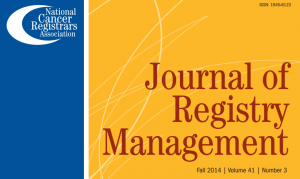
Francis P. Boscoe, Ph.D, Research Scientist, New York State Cancer Registry (NAACCR at-large Board Member)
There may not be any women named John, nor men named Mary, and perhaps only one boy named Sue. This observation led researchers at the New York State Cancer Registry to develop an edit based on first name and sex, using data on the most popular names by gender maintained by the Social Security Administration. Cases submitted to New York which violate this edit are sent back for review and correction as needed. A group of NAACCR researchers has now rigorously tested the edit using data from Florida, Alabama, and Alaska, and have found that between 19-45% of the cases flagged as possible errors were indeed errors – a very respectable rate of return. When applied specifically to male breast cancer, 100% of the cases flagged as possible errors were found to be errors – this is because breast cancers are so much more likely to occur in women to begin with. The next step will be to implement this edit nationwide.
Read Full Article (The abstract below is from an article in NCRA’s Journal of Registry Management, pages 120-124)
Abstract
 Background: Intrarecord edits on site–sex combinations are a standard tool to identify errors in the coding of sex in cancer registry data. However, the percentage of sex-specific cancers, like cervix, is low (20% of total invasive cases). Visual review and follow-back to improve the quality of the sex coding is labor intensive and typically only performed as a special project on subsets of data. The New York State Cancer Registry (NYSCR) created an edit for identifying potential sex misclassification in cancer registry data and has made its components available for use through the North American Association of Central Cancer Registries (NAACCR). The edit uses the most popular male and female first names based on decade of birth to identify potentially miscoded cases.This paper provides a summary of 3 independently conducted assessments of the sex edit at the central cancer registry level and includes a focus on misclassification of sex for breast cancer.
Background: Intrarecord edits on site–sex combinations are a standard tool to identify errors in the coding of sex in cancer registry data. However, the percentage of sex-specific cancers, like cervix, is low (20% of total invasive cases). Visual review and follow-back to improve the quality of the sex coding is labor intensive and typically only performed as a special project on subsets of data. The New York State Cancer Registry (NYSCR) created an edit for identifying potential sex misclassification in cancer registry data and has made its components available for use through the North American Association of Central Cancer Registries (NAACCR). The edit uses the most popular male and female first names based on decade of birth to identify potentially miscoded cases.This paper provides a summary of 3 independently conducted assessments of the sex edit at the central cancer registry level and includes a focus on misclassification of sex for breast cancer.
Methods: The sex edit was applied in 3 state cancer registries: Alabama, Alaska, and Florida. Alabama applied the edit to their entire database for 1996–2004 (N = 190,614) and compared the results to external databases available to most cancer registries. Alaska applied the edit to their entire database (N = 46,645) and were able to compare the results to 2 unique, state-based databases (Alaska Permanent Fund Dividend database and State Troopers database). Florida applied the sex edit to a sample of sites (n = 953,074) with particular attention to breast cancer. Results for breast cases were compared to results from an a priori quality control project on Florida male breast cancer cases. Using the Florida data, issues specific to male breast cancer were evaluated.
Results: In Alabama, 45% of 977 cases flagged as potentially miscoded sex were determined to be miscodes. In Alaska, 19% of 88 cases flagged as potentially miscoded sex were determined to be miscodes but the percent of miscoded cases identified by the edit more than doubled in the most recent years of data. For the Florida male breast cancer comparison, the sex edit correctly identified 729 of 903 cases known to be miscoded (81%) and was unable to assign a potential sex on the remaining 174 cases—but did not incorrectly flag any cases as miscodes.
Implications: The sex edit is a useful tool for identifying cases that require further review to confirm the reported sex code is correct. However, it only assesses 69%–84% of cases based on name and, of those flagged, only 19%–45% are true misclassifications. But for breast cancer, a site with a skewed male to female ratio, the verified misclassification rate was 100% of the male breast cancer cases flagged as potential females. The proper application of the sex edit can improve the quality of the sex variable and can greatly reduce the impact of miscoded sex on gender-skewed sites like male breast cancer.
The opinions expressed in this article are those of the authors and may not represent the official positions of NAACCR.
